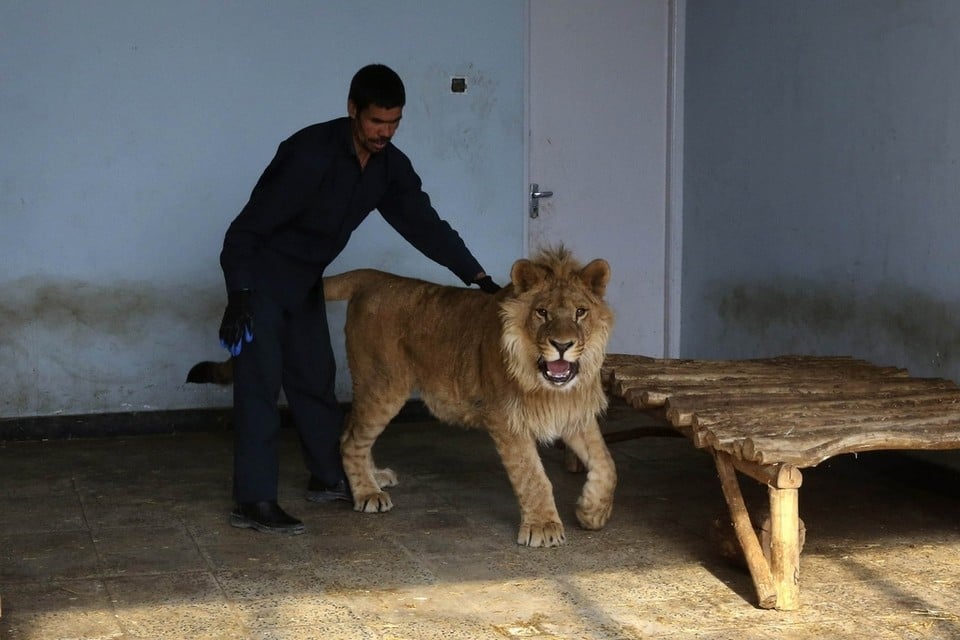
Now, more than a decade after his death, Afghanistan remains battered by war but Kabul zoo is buzzing again -- a haven for women, children and young lovers in a capital city that has little public space for anyone but men.
Brothers in Karachi take a walk on the wild side with unusual pet
The carnival of animal life may be a mundane affair compared to other places, but it seems like an anomaly in Kabul, a war-scarred city benighted by post-traumatic stress, which still faces a high risk of insurgent attacks. Men with children, women in blue burqas, crowds of young students -- girls and boys -- come to this haven to relax.
"My wife and I have come here to take a break and forget our pain and sorrows," explains Mohammad Ali Akbari, a resident of southern Ghazni province, one of the worst hit by the Taliban insurgency. "My wife is a bit sick. I brought her here so she can breathe fresh air and enjoy the normal things of life," he adds, as his wife gazes at a bear inside a cage. Children peer through a wire mesh fence, amused by monkeys swinging their tails and frolicking from one tree to another, as some of them imitate their whoops and barks.
Loud music emanates from the zoo canteen near an aviary with pheasants and other birds, as families huddled in conversation around burgers, fries and canned sodas. Other picnickers seek respite from the scorching afternoon heat under the shade of trees, while enjoying platters of cantaloupe, honeydew and watermelon. Blushing young lovers sit on a bench opposite the gazelle cage, seeking an escape from prying eyes in a city where harassment is otherwise commonplace.
Instead of cats and dogs, why not get a snake, ask brothers
The Kabul zoo -- the only one in the country -- is located in the heart of the Afghan capital, surrounded by a dense warren of muddy flat-topped houses. Before the 1992-1995 civil war, the zoo was home to many exotic animals.
But most of them were either killed or escaped as mortar rounds slammed into the zoo during fighting, leaving only a bear with a nose injured by children who jabbed it with a stick, a scattering of monkeys, an assortment of birds of prey -- and Marjan, the showpiece lion who was blinded by a grenade blast in 1993. Many of the smaller and tamer animals, such as sheep and goats, were stolen for food. More exotic creatures, such as rare species of birds, were sold on the black market or smuggled out of the country.
The zoo has since undergone a slow and painful reconstruction, now housing around 600 animals, many of them gifted by countries such as India and China. "It is now more than a zoo," said Aziz Gul Saqib, who has served as director for more than a decade. "Families feel safe here. They see the zoo as a place for rejuvenation," he told AFP, adding that last year more than 700,000 people visited the zoo, including 50,000 students. The zoo, he said, earned 17 million Afghanis ($250,000) last year from ticket sales and other revenues, making it self-sustainable.
It is equipped with hi-tech surveillance cameras and loudspeakers -- often used to chide those who tease the animals. "It is very important to teach people about wildlife because exotic animals in Afghanistan are on the verge of extinction," Saqib said.
Raju, the tiger dies at Karachi Zoo
Marjan was seen as a symbol of Afghanistan's national survival after living through coups, invasions, the grenade attack which scarred his face and blinded him, civil war and the hardline Taliban era which ended in 2001. He died in 2002 and is now buried in the zoo, but his bronze statue greets visitors at the entrance with many visitors posing beside it for selfies and photographs.
A new Marjan made headlines around the world when AFP found him in 2014, living on the roof of a compound in the upmarket Taimani district of the capital. Government inspectors took him from the owner as the lion's health declined and brought him to the zoo. He did not live -- but as the conflict grinds on, the zoo itself has become a symbol of Afghan endurance.























COMMENTS
Comments are moderated and generally will be posted if they are on-topic and not abusive.
For more information, please see our Comments FAQ